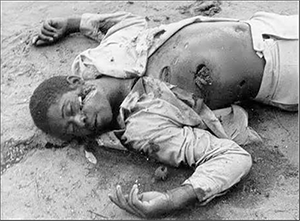HEALTH
Ebola Virus

GENEVA - According to information supplied by the United Nations World Health Organization (WHO), the emergence of an Ebola virus disease outbreak in West Africa in 2014 has become a challenge to the 3 countries involved, as the governments of Guinea, Liberia and Sierra Leone work intensively with WHO and other partners to ramp up a series of measures to control the outbreak.
Since March 2014, more than 600 cases of Ebola and over 390 deaths have been reported in Guinea, Liberia and Sierra Leone. While the number of suspected, probable and confirmed cases and deaths changes rapidly, the outbreak is causing concern among health authorities because the deadly disease is being transmitted in communities and in health-care settings, and it has appeared in cities as well as rural and border areas. The disease, which causes severe haemorrhaging and can kill up to 90% of those infected, is spread by direct contact with the blood and body fluids of infected animals or people.EBOLA is a disease caused by infection with Ebola virus, named after a river in the Democratic Republic of the Congo in Africa, where it was first recognized in 1976. Since then, Ebola hemorrhagic fever - a severe, often-fatal disease in humans and nonhuman primates - has appeared sporadically.
Here is information on Ebola from the U.S. Centers for Disease Control and Prevention and the World Health Organization:Confirmed cases of Ebola HF have been reported in the Democratic Republic of the Congo, Gabon, Sudan, the Ivory Coast, Uganda, and the Republic of the Congo. Ebola HF typically appears in sporadic outbreaks, usually spread within a health-care setting (a situation known as amplification). It is likely that sporadic, isolated cases occur as well, but go unrecognized.
The Ebola virus belongs to the Filoviridae family (filovirus) and is comprised of five distinct species: Zaïre, Sudan, Côte d’Ivoire, Bundibugyo and Reston. Zaïre, Sudan and Bundibugyo species have been associated with large Ebola haemorrhagic fever (EHF) outbreaks in Africa with high case fatality ratio (25–90%) while Côte d’Ivoire and Reston have not. Human infection with the Ebola Reston subtype, found in the Western Pacific, has only caused asymptomatic illness. The natural reservoir of the Ebola virus seems to reside in the rain forests of the African continent and in areas of the Western Pacific. There is evidence that bats are involved, but much work remains to be done to definitively describe the the natural transmission cycle.
Researchers have hypothesized that the first patient becomes infected through contact with an infected animal. After the first case-patient in an outbreak setting is infected, the virus can be transmitted in several ways. People can be exposed to Ebola virus from direct contact with the blood and/or secretions of an infected person. Thus, the virus is often spread through families and friends because they come in close contact with such secretions when caring for infected persons. People can also be exposed to Ebola virus through contact with objects, such as needles, that have been contaminated with infected secretions. Burial ceremonies where mourners have direct contact with the body of the deceased person can play a significant role in the transmission of Ebola. Nosocomial transmission refers to the spread of a disease within a health-care setting, such as a clinic or hospital. It occurs frequently during Ebola HF outbreaks. The incubation period for Ebola HF ranges from 2 to 21 days.
Ebola is characterized by the sudden onset of fever, intense weakness, muscle pain, headache and sore throat. This is often followed by vomiting, diarrhea, rash, impaired kidney and liver function, and in some cases, both internal and external bleeding. Some patients develop hiccups. Laboratory findings show low counts of white blood cells and platelets as well as elevated liver enzymes. Diagnosing Ebola HF in an individual who has been infected only a few days is difficult because early symptoms, such as red eyes and a skin rash, are nonspecific to the virus and are seen in other patients with diseases that occur much more frequently.




















